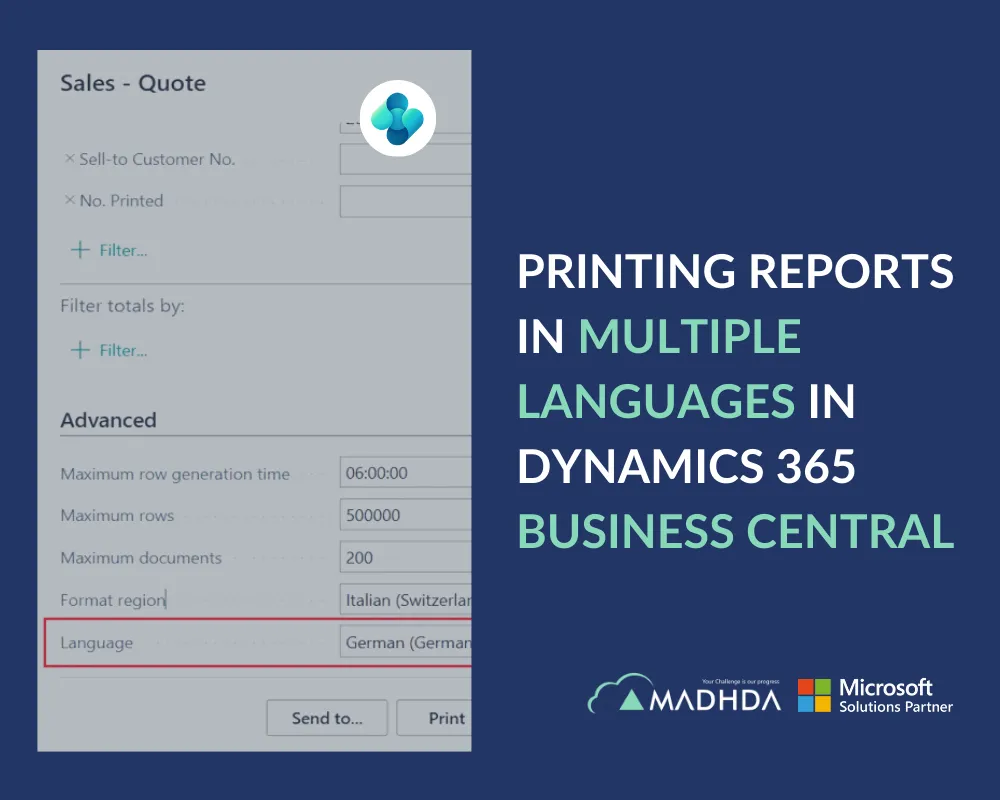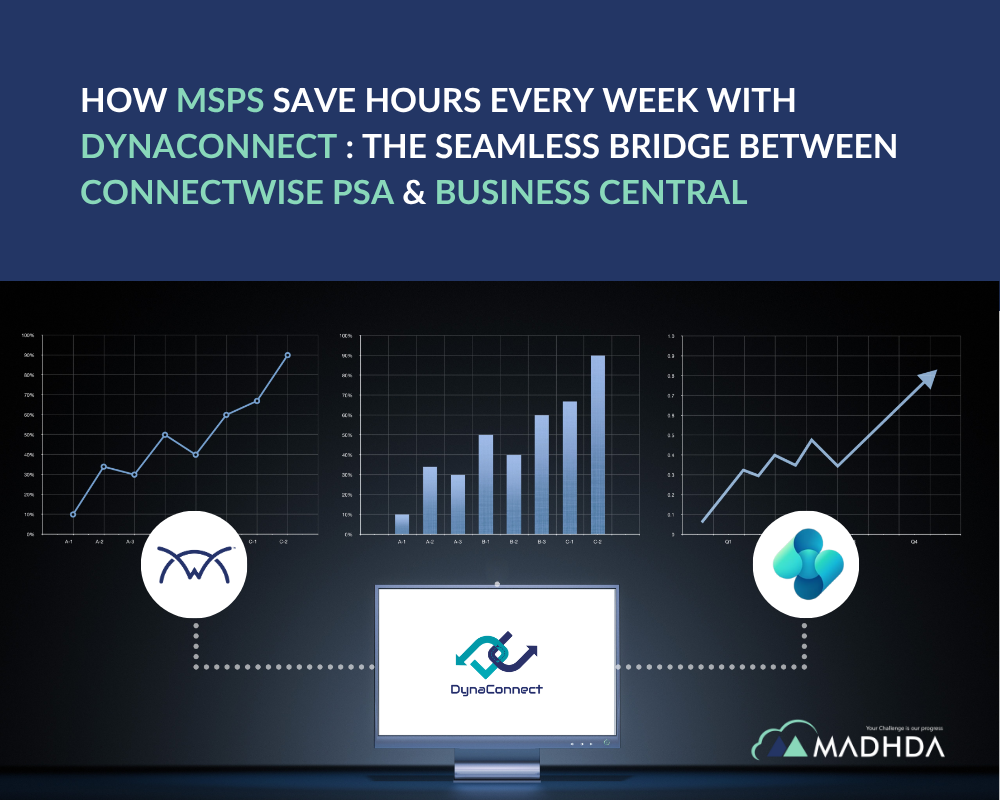Streamline compliance, eliminate manual errors, and make group VAT filing effortless.
Let us give you a little background.
While working with several UK-based businesses operating across multiple legal entities under a single VAT registration, one common challenge stood out: VAT compliance was chaotic, time-consuming, and confusing.
Even though Microsoft Dynamics 365 Business Central offers a powerful VAT Group Management feature, there’s barely any detailed documentation available — not even on Microsoft Learn.
Why This Guide Matters?
Many teams struggle with setting it up the right way or miss key configuration steps, resulting in failed submissions or reporting mismatches.
So we madhda decided to put together this blog — a straightforward, detailed, and practical guide that walks you through the entire Group VAT Submission process step by step.
This comprehensive guide walks you through the 10 essential steps for Group VAT submission in Business Central—from configuring service connections to creating group VAT returns and retrieving liabilities. You’ll also learn about the common challenges of not using VAT Group Management and how this functionality significantly reduces manual errors, improves compliance, and enhances financial governance.
Whether you’re a finance lead, system administrator, or Dynamics 365 consultant, this guide will help ensure your VAT process is accurate, efficient, and compliant.
Step-by-Step Guide: Group VAT Submission in Dynamics 365 Business Central
1. Configure Service Connections:
Choose the 🔍 icon, enter Service Connections, and then choose the related link.
- On the Service Connections page, choose HMRC VAT Setup.
- To open a GOV.UK website and request an authorization code, choose Process, then Request Authorization Code, and then choose Continue.
- Sign in with your HMRC credentials. To allow the Dynamics 365 Business Central MTD VAT application to interact with HMRC on your behalf, choose Grant authority.
- A confirmation page displays “Authorization granted” and an authorization code. To copy the authorization code, choose Copy.
- Return to the service connection you are setting up and paste the authorization code in the Enter Authorization Code field. Then choose Enter. Note that the authorization code is valid for 10 minutes. To set up the connection, you must enter the code in Business Central before it expires.

2. Setup VAT Group Representative:
Setup VAT Group Representatives from VAT Group Management Option in Assisted Setup in the Representatives Company.


| Group Settlement Account | Define ‘Group Settlement Account’. This account is used to close post settlement account at Group Level. |
| VAT Settlement Account | Define ‘VAT Settlement Account’ where due or receivable amount will be posted to close VAT Entry when we run and post VAT Settlement process.
This VAT settlement is referred to Representative own liability. |
| VAT Due Box No | Defined Box No as ‘5’ which represent the ‘Net VAT to be paid (+); or to be reclaimed (-);’ in VAT return. |
| Group Settlement General Journal | Define General Journal Template specifically design to post ‘VAT Group Settlement’ |
3. Setup VAT Group Member:
We need to setup VAT Group Member from VAT Group Management Option in Assisted Setup in Member Company.
Follow the process and select the VAT Group Code as ‘Member’ and click ‘Next’:

Group Member will establish Member Connection with their Group Representative.

API URL will be used by Group Member company to contact their VAT Group Representative in BC.
- API URL can be created as below:
API URL of the Group Representative:
https://api.businesscentral.dynamics.com/v2.0/[TENANT-ID]/[ENVIRONMENTNAME]
In above URL, add Tenant ID and Environment name and paste it to API URL field.
Tenant ID and Environment name can be view as below by going to Production environment URL of Representative company:
For example, Highlighted in Yellow is tenant id and green highlighted refers to Environment name.
![]()
- Group Representative Company:
Enter ‘Group Representative Company’ name. Here Company name must be entered instead of ‘Display Name’ in Companies page.

Once we filled up above information, click on ‘Next’. System will redirect to login with dedicated user credentials of Representative to authenticate that process is initiated by the any approved user.

If all details are correct, then this message will appear.

Once click on ‘Ok’, system will ask to select the VAT report configuration. We need to select VAT report version of ‘HMRC MTD’ as seen below and click on Next.

To check whether configuration is successful done or not, click on ‘Test Connection’.

If everything is good, then system will show below message then click on ‘Finish’.

Once we complete the process:
- Group member ID generated for Group Member Company needs to be updated in Group Representative company, so that they will make the Group member as “Approved Member of the Group”.
Go to Representative company and search for ‘VAT Group Approved Members’.

Follow the above process to add group member’s company. Once we completed, Group Members will be updated into ‘VAT Report Setup’ page as ‘Approved Members’ in ‘VAT Group Management’ FastTab as below:

- Report Version will be auto update to ‘VAT Group’ for all Group members.

-
VAT Report Setup
Follow below steps to configure ‘VAT Report Setup’ in ‘Representative’ and ‘Group Member’ Company.


Navigate to VAT Report Setup, and focus on the Making Tax Digital fast tab:
- Enable: Active this Boolean
- Report Version:
For Representative Company: HMRC MTD
For Group Member: It will be auto
- Period Reminder Calc: Enter a date formula to get reminder before due date.
- Manual Receive Codeunit: 10534 MTD Manual Receive Period
- Receive Submitted Return Codeunit: 10536 MTD Receive Submitted
- User IP Address Service: An endpoint for IP address verification (see below)
5.Create VAT Return Period from HMRC:
VAT Return Period must be created in Representative and Member Company before proceeding for creation and submission of VAT Return.
Choose the icon, enter VAT Return Periods, and then choose the related link.
- On the VAT Return Periods page, choose the Get VAT Return Periods action.
- Enter the Start Date and End Date to specify the period for which to get the VAT return periods and then choose OK.

The VAT obligations are now retrieved from HMRC, and you can view them on the VAT Return Periods page. A confirmation page shows how many obligations were retrieved
Do not create VAT return periods manually when submitting VAT Returns to HMRC. VAT return periods must be retrieved from HMRC using the steps above. Creating them manually will result in inability to submit VAT Returns.
6. Prepare VAT Return by Group Members:
VAT group members use the standard processes to prepare VAT returns in their own companies.
The only difference is VAT Group member to choose the VATGROUP report version in VAT Return Card while submitting the VAT return. This means VAT return will be submitted by VAT Group Member to the VAT group representative rather than to the HMRC.
Once the group member has submitted the return, it will be available in “VAT Group Submissions” Page in the books of Representative Company.
Note:
- Group members company need to finalize the VAT statement before submitting the data to ‘Representative Company’.
- Once VAT return submit to ‘Representative’ Company, system will not allow to do any modification. Therefore, before submitting the VAT return ensure that VAT return has correct value.
- After submitting VAT return, Group member can proceed to ‘Calculate and Post VAT Settlement Process’.
- User can submit the VAT return to Representative company only when VAT Return period is ‘Open’.
7.VAT Group Submission Page:
The VAT Group Submissions page lists the VAT returns that members have submitted.
The page serves as a draft location for the submissions until the VAT group representative includes them in a VAT return for the ‘group’.
User can open the submissions to review the VAT for the individual boxes reported by the VAT group member.
8. Creating Group VAT Return:
To report VAT on behalf of the group, on the VAT Returns page in Representative books, Create a VAT return for Group Representative’s company only.
Afterward, include the most recent VAT submissions from VAT group members by choosing the Include Group VAT action.

Once the VAT Group representative’s VAT Return has been submitted to the authorities on behalf of the entire group, it will normally run the Calculate and Post VAT Settlement action in Representative Company Books.
Once the Group VAT Return is submitted, User can run the Calculate and Post VAT Settlement action in VAT Group Member’s Company Books.
9.VAT Liabilities and Payment:
If Business want to check the status of your VAT, you can retrieve information from HMRC about your VAT liabilities and payments. VAT liabilities are the amounts that you owed to HMRC and show if there are outstanding amounts to be paid. VAT payments are the actual payments your company has made to HMRC.
To retrieve VAT liabilities from HMRC:
Choose the icon, enter VAT Liabilities, and then choose the related link.

- On the VAT Liabilities page, choose Process, and then select Get Liabilities.
- Enter the Start Date and End Date of the period to retrieve VAT liabilities for, and then choose OK.
To retrieve VAT payment from HMRC:
Choose the icon, enter VAT Payments, and then choose the related link.

- On the VAT Payments page, choose Process, and then choose Get Payments.
- Enter the Start Date and End Date of the period to retrieve VAT payments for and then choose OK.
The VAT payments are now retrieved from HMRC, and you can view them on the VAT Payments page. A confirmation page shows how many VAT payments were retrieved.
10. VAT Return Status:
A successful submission of the VAT Return results in a status of Accepted on the VAT Return. This status is based on the submission result at the HMRC. If the status after submission isn’t set to Approved, a previously submitted VAT Return can be retrieved from the HMRC.

Note: Representative company can have idea about whether Group Member has submitted data for return from ‘Group Member Submission’ field.
Depending on where they are in the process, VAT returns can have one of the following statuses:
| Status | Description |
| Open | When you create a new VAT Return. This status lets you run the Suggest Lines action. If you need to correct values, run the Suggest Lines action again. You can’t submit a VAT Return with this status. |
| Released | Status is changed when you manually run the Release action. The Errors and Warnings FastTab is available. You can’t make changes or run the Suggest Lines action. To make changes, you must reopen this VAT Return. |
| Rejected | If your submission wasn’t successful (for example, if authentication failed), the VAT Return status is changed to Rejected. You can’t reopen the VAT Return from this status. |
| Submitted | VAT Return is submitted using the Submit action or it’s marked as submitted using the Mark as Submitted action. |
| Accepted | VAT Return gets this status if the report is marked with the Mark as Accepted action. The Accepted status can be assigned automatically after user sends the VAT Return to the tax authority (Business Central calls the Get VAT Returns method and checks whether the VAT return is in the response). If the VAT Return report is marked as Accepted, you can run the Calculate and Post VAT Settlement action. |
| Partially Accepted | Business Central can assign the Partially Accepted status related to GovTalk information that was collected using the Get VAT Returns method. |
| Closed | When request called Get VAT obligations check whether the obligation for which the user created the VAT return is closed. Business Central automatically marks the VAT Return as Closed. |
Receive previously submitted VAT returns from HMRC
- Choose the icon, enter VAT Return Periods, and then choose the related link.
- On the VAT Return Periods page, choose the relevant VAT return period.
- On the VAT Return Period Card page, choose the Receive Submitted VAT Returns action.
Conclusion:
Managing VAT obligations effectively is critical for businesses operating with multiple entities under a single tax registration. The VAT Group Management functionality in Business Central streamlines this process by centralizing VAT reporting and compliance, reducing administrative overhead, and minimizing errors.
By leveraging this feature, organizations can ensure accurate VAT settlements, maintain better visibility over intercompany transactions, and strengthen overall financial governance.
If your business structure involves multiple legal entities and you are looking to simplify your VAT processes, exploring the VAT Group capabilities in Business Central can be a strategic move.
Feel free to reach out or leave a comment if you have questions or would like insights into how this can be tailored to your specific business needs.
Challenges of Not Using VAT Group Management in Business Central
Organizations with multiple legal entities operating under a single VAT registration often underestimate the complexities involved in managing consolidated VAT obligations manually. If you are not leveraging the VAT Group Management functionality available in Business Central, you may encounter several challenges, such as:
✅ Manual data consolidation:
Without an automated VAT group setup, finance teams must manually gather VAT data from each entity. This increases the risk of inconsistencies, missing transactions, and time-consuming reconciliation.
✅ Higher error rates:
Manual preparation of consolidated VAT returns can lead to calculation mistakes or overlooked intra-group transactions, resulting in incorrect filings and potential penalties from tax authorities.
✅ Limited visibility:
Tracking VAT liabilities and settlements across multiple companies becomes cumbersome, making it harder to maintain clear audit trails and respond promptly to compliance reviews.
✅ Inefficient month-end closing:
The absence of automated intercompany VAT offsetting means longer closing cycles, with teams spending unnecessary time balancing accounts and preparing return reports.
✅ Compliance risks:
Each entity managing VAT obligations independently could inadvertently double-declare or miss transactions, exposing the group to audit findings and financial penalties.
By not utilizing the standard VAT Group Management capabilities in Business Central, companies essentially rely on manual workarounds, which undermine efficiency, accuracy, and regulatory compliance. Implementing this functionality ensures a streamlined, automated, and compliant approach, freeing up valuable resources and providing peace of mind.
Final Thoughts
Managing VAT across entities doesn’t have to be messy. With Business Central’s VAT Group capabilities, you gain automation, control, and confidence in your tax process.
If your company operates under a single VAT registration with multiple legal entities, it’s time to embrace this functionality.
Ready to simplify your VAT Group submission process?
Whether you’re considering a fresh implementation or want to optimize your existing Business Central environment, our experts can help.
📩 Contact us today to tailor the VAT Group Management setup to your business structure and ensure full HMRC compliance.
Need Help with Setup or Customization?
We’re happy to guide you through implementing or auditing your VAT Group configuration in Business Central.
📩 Reach out to learn how this can be tailored to your specific structure
💬 Or leave a comment below with your questions — we’re listening!











